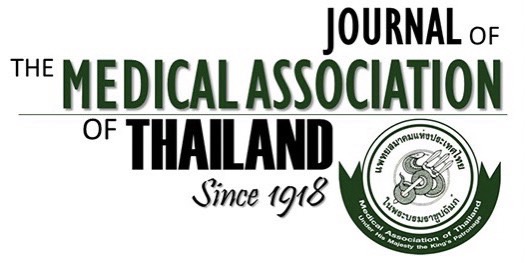Correlation of Graft Position, Knee Laxity and Clinical Outcome: Comparison with Native Anterior Cruciate Ligament Using Magnetic Resonance Imaging Study
Suriyapong Saowaprut MD*, Thanathep Tanpowpong MD*, Chaiwat Piyaskulkaew MD*
Affiliation : * Institute of Orthopaedics, Lerdsin General Hospital, Bangkok, Thailand
Objective : To compare the sagittal obliquity of anterior cruciate ligament graft with normal native anterior
cruciate ligament in contralateral knee, to determine the effect of sagittal obliquity and axial femoral tunnel
graft placement on stability and functional knee score (Lysholm), and to measure size of graft after complete
ligamentization.
Material and Method: Seventy single tunnel quadruple hamstring anterior cruciate reconstructed knee in
unilateral ACL injury patients were evaluated at 18 months after surgery. At follow up, patients were evaluated
including measurement of knee laxity by using side to side different on KT 1000 arthromeres and clinical
outcome by completed Lysholm functional knee questionnaires. Sagittal T1 weighted magnetic resonance
image with complete dimension of graft from origin to insertion on each side of knee were depicted to compare
the obliquity by measuring the intersection angle of the graft line with the tibial plateau plane. The axial
femoral tunnel was determined by angle between anteroposterior axis of distal femur and long axis of femoral
tunnel. The diameter of graft was also measured.
Results : Graft obliquity was average 58° with range between 41° and 69°. In contralateral native ACL
obliquity was average 50° with range between 33° and 63°. The difference between the two groups was
statistically significant (p < 0.0001). Average axial femoral tunnel was 36° with range between 10° and 56°.
Knee laxity (KT-1000 arthrometer; average pre-op = 6, post-op = 3) and Lysholm knee scores (average score;
pre-op55, post-op score 89 ) were significantly improved after surgery (p < 0.01). There was no correlation
between degree of sagittal obliquity and axial femoral tunnel with knee laxity and functional score in this
series. Graft size was increased in average 8% after 18 months post-operatively.
Conclusion : ACL grafts in patients with appropriate tibial tunnel placement were more vertical than native
ACL. There was no significant effect of degree of sagittal obliquity and axial femoral tunnel to antero-postero
stability and knee score. ACL graft size was increased in diameter during post-operative period. Graft-notch
distance should be considered during operation.
Keywords : Anterior cruciate ligament, Joint instability, Knee joint, Magnetic resonance imaging, Range of motion, Articular



